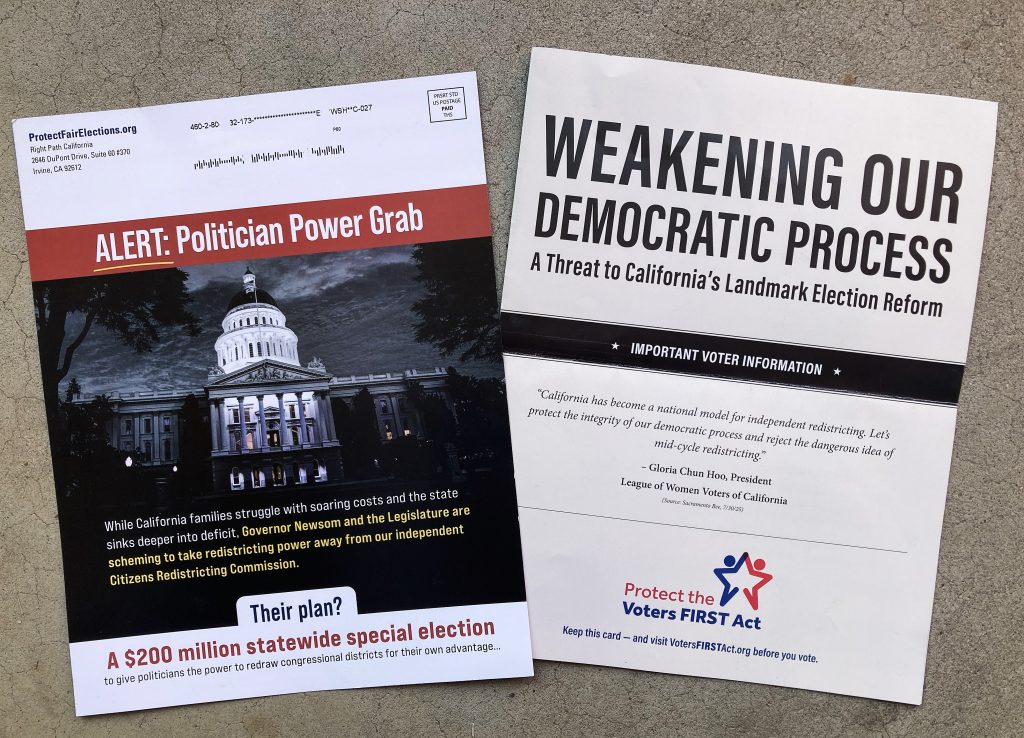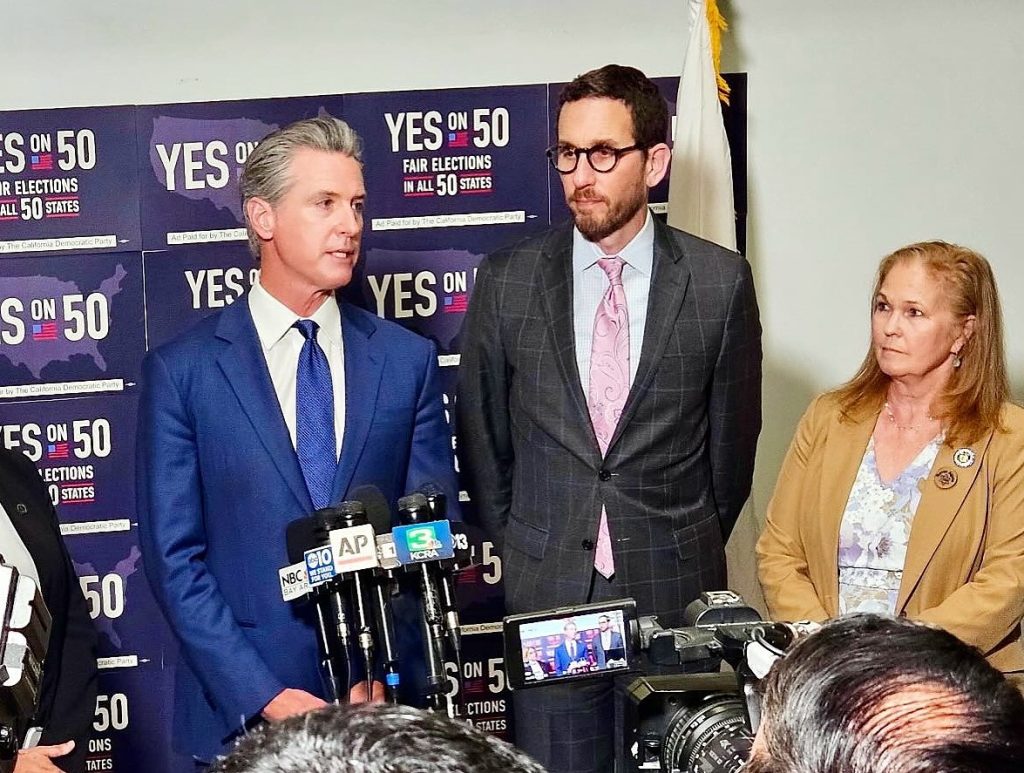LaMalfa comes under threat and Gallagher makes Bible references as Butte County remains in the crosshairs of California’s fight to counteract Texas redistricting
By Ken Magri
On August 20, the Texas legislature voted to redistrict its state, giving Republican candidates a greater disproportional advantage on the 2026 US House of Representatives election map.
This was done at the request of President Donald Trump, who’s made it known he wants five more Republican seats in Texas. Such a gain would help tip the 2026 elections towards Republicans in the House of Representatives, allowing them to keep their majority.
To nullify those changes in Texas, California Governor Gavin Newsom signed a bill creating a special November 4 election for an initiative called Proposition 50. It will ask California voters to create five more possible seats for Democrats through the 2030 election. “It’s not just about California,” said Newsom at a press conference last week. “It’s about the United States of America.”
Chico is being pulled into this partisan political warfare between two states because one of the newly created districts will challenge US Representative Doug LaMalfa’s re-election chances.
Some praise the California Democrats nuanced logic of this special redistricting election while others say it is “gerrymandering” and no different from what Texas is doing.
What is redistricting and gerrymandering?

“Redistricting,” which happens after every 10-year census, adjusts election maps to better reflect changes in population demographics. To avoid accusations of political interference, many states like California attempt to be fair by appointing independent boards to draw new district maps. Other states like Texas designate elected state lawmakers to draw the maps for their own state.
“Gerrymandering,” according to the Merriam Webster Dictionary, is a less equitable form of redistricting which seeks “to divide or arrange (a territorial unit) into election districts in a way that gives one political party an unfair advantage.”
The term goes back to 1812, originating with the Boston Gazette reacting to Massachusetts Governor Elbridge Gerry. The governor blatantly changed the voting maps to gain seats for his party. The Gazette compared one strangely shaped district to a salamander, and the term “gerry-mander” was created.
Both redistricting and gerrymandering require a deep knowledge of voter demographics regarding who lives where and how they regularly vote.
But gerrymandering tactics rely on four controversial practices, called “cracking, packing, hijacking and kidnapping.” Cracking splits up an opposition voting bloc into two or more districts in order to weaken the concentration and deny that voting bloc an election win.
Packing concentrates desired voters into a district to achieve a majority, even if the boundary lines look unreasonably extended.
Hijacking merges two districts together, forcing incumbents of the same party to run against one another and ensuring that one loses. Kidnapping involves changing a district boundary line to eliminate the address of an incumbent, making them ineligible to run again or forcing them to move to the new district.
A recent Reuters/Ipsos poll found that 55% of Americans believe gerrymandering is detrimental to democracy. This included 71% of Democrats but only 46% of Republicans.
California legislators vote to mess with Texas

One day after the Texas legislature changed its districts, California’s legislature voted to seek permission to create new maps for the 2026 election. The effort is designed to flip five districts from Republican to Democrat, balancing out the Texas impact.
The main difference is that California, which currently uses an independent redistricting process, will let voters decide in November whether they want to put that process on hold for the next three election cycles, until after the 2030 census. Proponents call Proposition 50 a measure of transparency codified by popular vote, something that Texas legislators didn’t use when changing their maps.
California’s 43 Democrat-held congressional seats represent an estimated 33.03 million residents, while the remaining 9 seats held by Republicans represent an estimated 6.4 million residents.
A recent Democratic Party poll found that 57% of California voters back this California redistricting effort. That number is up six points from July. Another 35% oppose redistricting and 8% remain undecided.
While opposing Proposition 50 during the assembly debate, Minority Leader James Gallagher, who represents some of Butte County, quoted from the Bible as he made a plea for no action, saying that Trump, Texas and California were all doing the wrong thing.
“You move forward fighting fire with fire and what happens? You burn it all down,” said the 3rd Assembly District Republican, who also represents parts of Glenn, Placer and Sutter counties.
“If there is one weakness that we have right now in our republic, it is that legislators are not standing up to executives of their own party,” Gallagher added.
State Senator Scott Wiener, a Democrat representing San Francisco, stated in an email that “none of us wanted to be here. Politicians shouldn’t draw the maps that determine how people get represented.”
“But what’s happening now is simply unprecedented,” Wiener continued. “We are facing a grave threat to our democracy. But unlike President Trump and Texas’s Republican leaders, we aren’t making the decision for you. All we are doing, all we’re able to do under California’s Constitution, is draw up a proposal and put it on the ballot for you, the voters, to decide,” the email stated.
How does this affect Chico’s congressional representation?
Each congressional district represents approximately 760,000 residents. The new redistricting map would not change the number per district. Instead, it takes conservative voters out of some districts and capitalizes on new liberal voters coming in.
Up and down the state, counties closer to the coast or the border with Mexico are more populated and generally more liberal. As one travels east across the Central Valley and toward the Sierra Nevada, counties become less populated and more conservative.
In the north state, redrawn maps will have Republican-held congressional districts extending further towards the west where liberal voters and their candidates have more strength.
Redistricting would take conservative voters away from Doug LaMalfa’s 1st Congressional District stronghold in the northern and eastern corner of California. It would replace them with more liberal voters from the Napa-Sonoma area and parts of Santa Rosa.
Likewise, Kevin Kiley’s 3rd Congressional District, which stretches down California’s eastern side from Mount Lassen to the Mojave Desert, will change in the favor of Democrats. The new map puts a more liberal section of Sacramento County into Kiley’s redrawn district while moving most of the Sierra Nevada section to Republican Tom McClintock’s 5th Congressional District.
LaMalfa, Kiley and the state’s remaining seven Republican House members issued a July 25th press release criticizing Democrats, arguing that two wrongs don’t make a right.
“It’s a shame that Governor Newsom and the radical left in Sacramento are willing to spend $200 million on a statewide special election, while running a deficit of $20 billion, in order to silence the opposition in our state,” stated the press release.
LaMalfa and the Republican delegation also pledged to fight this redistricting effort “by whatever means necessary to ensure the will of the people continues to be reflected in redistricting and in our elections.”
Proposition 50 campaign already underway
On the day Governor Newsom signed the bill to create the fall election, opposition flyers were already arriving in Chico voters’ mailboxes. One such flyer was sent by the non-profit group Hold Voters Accountable, financed with a $10 million donation by Charlie Munger, Jr.
The mailer falsely implied that the League of Women Voters opposes Proposition 50.
But the league immediately issued a press release denying the implication. “You may have received a mailer from ‘Hold Voters Accountable’ about the redistricting ballot initiative this November. By naming our organization and quoting Gloria Chun Hoo, the mailer wrongly implies that the League of Women Voters of California is part of their coalition and endorses the information contained in the flyer,” said the statement.
“This implication is not correct—we are not part of that coalition,” the statement continued. “The League of Women Voters of California did not authorize this action.”
On the other side, the “Yes on 50” campaign has already been endorsed by President Barack Obama and received over nine million dollars in donations. Major donors include the House Majority political action committee for Democrats, Governor Newsom’s leftover 2022 campaign fund, California’s SEIU labor union for service employees and California businessman and philanthropist Bill Bloomfield.
The post When gerrymandering trumps redistricting: Chico is in the middle of a national political battle appeared first on Chico News & Review.

